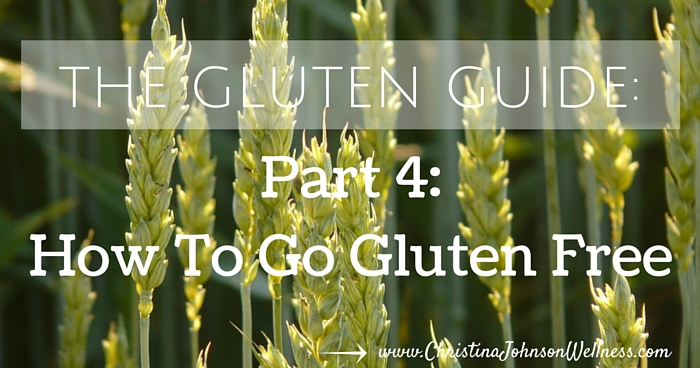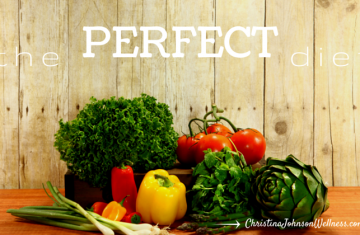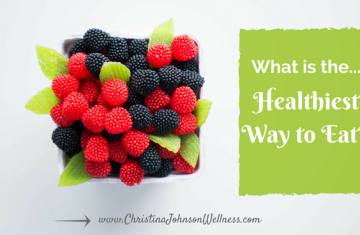If you’ve read the three previous parts of The Gluten Guide (What is Gluten, What Does Gluten Do To Your Body, and Should I Go Gluten Free), then you just might be ready to take the leap and learn how to go gluten free.
I made the decision about 5 years to go to avoid gluten in order to improve my health. Obviously, since I have stuck with it for 5 years, you can probably guess that I feel strongly that it has improved my health and my life in many ways.
However, the journey to a gluten free life was not obstacle free for me. I spent lots of hours trying to figure out exactly which foods I should avoid, how to cook and prepare meals that don’t have gluten in them (without spending hours in the kitchen or breaking the bank!), how to eat out, and what to do in social situations.
Plus, I wanted to know how to do all of this without feeling deprived and while still being able to enjoy my food…now that was a tall order!
While I can’t cover everything I learned over the past 5 years about how to go gluten free, I do want to share with you my top 8 tips for how to go gluten free so that your learning curve will be shorter than mine!
1- Avoid Gluten Completely
I discussed in detail in Part 3 of The Gluten Guide that the gluten protein can have a long-lasting impact on your body. Experts agree that it can stay in your system for at least 2 weeks, but some experts believe it can actually impact your body for as long as 3 months after you eat it.
So gluten is not something that you can have “in moderation” without consequences to your health. If you are sensitive to gluten or have celiac disease, you will only experience the true benefits of going gluten free once you remove it completely from your diet.
2- Look For Hidden Sources of Gluten
Unfortunately, gluten is everywhere! It’s not just in the food you eat, but it can also be found in things like beauty products, cosmetics, and medications.
To go gluten free, you need to be vigilant about ALL of the hidden sources of gluten and educate yourself on common ingredients that may contain gluten. For example, the following items that are often found in processed foods have all been known to contain gluten at times: malt, modified food starch, dextrin, maltodextrin, natural flavors, artificial flavors, and brown rice syrup.
When buying packaged food items, it is best to look for a certified gluten free label.
3- Avoid the Gluten Free Aisle
Ok, this one may not make much sense at first glance…if we’re trying to avoid gluten, why would you avoid the gluten free aisle?
Several problems exist with a lot of the food found in the gluten free aisle. First, most of these foods are still extremely processed. You can find gluten free chips, crackers, cereal, spaghetti noodles, cookies, and on and on. Yes, these foods are free of gluten, BUT they are still highly processed and full of sugar.
In fact many of the gluten free flours (such as rice, potato, and tapioca) can spike your blood sugar even more than gluten containing grains.
So keep in mind that being free of gluten does not automatically make something healthy for you to eat. For example, we all know that a gluten free doughnut would still be full of sugar and artificial ingredients that would definitely not benefit your health!
The gluten free foods found in the gluten free aisle also have considerably less nutrients in them than real, whole foods will have. These gluten free foods also contain preservatives, which are just unnecessary chemicals that we don’t need in our bodies.
Finally, these gluten free processed foods are often made with refined oils that are highly processed, usually damaged, and high in omega-6s [1]. (For more information on the dangers of these refined oils, you can read this article.)
4- Eat REAL Food
If you have to be super careful about looking for hidden sources of gluten and you can’t eat gluten free processed foods, then what should you eat?
The short answer…Eat REAL Food. Look for food that is in as close to its natural, unprocessed state as possible so that you will enjoy all of the nutrients that your body needs in order to thrive. In addition, you want to avoid eating foods that have been processed or that have had man-made chemicals added to them.
If you would like to know exactly which foods you should eat and which foods you should avoid in order to be healthy and to be sure that you are avoiding gluten, you can download my one page cheat sheet, Eat REAL Food, that I have created for you by clicking here.
5- Eating Out Is Still Possible
Eating gluten free at restaurants is not nearly as difficult as it used to be because so many restaurants now have gluten free menus. Most restaurants can also tell you what items on the menu are dairy free if you ask about that, too.
Be cautious, however, about not ordering overly processed foods just because they are gluten free…like that gluten free pizza that may be oh-so tempting or the hamburger with the gluten free bun.
Here’s what I personally do when I’m going out to eat:
- I usually choose a meat dish (like a steak or a hamburger without the bun) and ask if it is gluten free. You may be surprised to find out that sometimes the seasonings used on meat may not be gluten free, so it is always wise to ask.
- For a side dish, I try to find a salad (without croutons) that comes with a gluten-free salad dressing. You can even opt for oil and vinegar for a good salad dressing alternative. Other side options could be vegetables, a baked potato, or a sweet potato. Although I don’t eat grains and legumes often, I will sometimes have a side of rice or beans (if they are gluten free) when I am eating out so that I can have some variety.
- These options are not always the most exciting thing on the menu, which is why I often choose to go to ethnic restaurants because they use different combinations of spices that I don’t often cook with at home. I have had luck finding local Chinese, Indian, and Mexican restaurants that all have gluten free menus.
- Look at the restaurant’s website before you go. You can usually tell if they have a gluten free menu or if they have options that will work for you. Deciding what you will order before you leave the house also takes the pressure off in the moment and makes it easier to make a healthy choice.
6- Don’t Be Afraid to Tell People You Have a Gluten Sensitivity
Most people understand food allergies. I usually opt to simply tell people: I can’t eat gluten. I don’t go into all of the details about how I have a sensitivity to it, and not a true allergy. I just keep it simple, and people understand.
Once I share this with someone, then it takes the pressure off of me if I turn down food that they offer to me. I find it hard to decline food when people take the time to prepare it for me, but it became much easier once I started telling people that I can’t eat gluten.
Also, before I go to a friend’s house for a meal, I usually eat a little something before hand so that I’m not starving if there are not a lot of gluten free options. I also offer to bring a side dish so that I know I will have something to eat. And then, I just don’t make a big deal out of what I choose to eat…or usually, what I choose not to eat.
7- Discover Your Personality Type
This topic may seem kind of random when tossed into my list of tips for how to go gluten free, but hear me out because this may make your transition to eating gluten free a whole lot easier!
According to Gretchin Ruben, people have either a moderator or an abstainer personality type [2]. Let’s try to figure out which type of person you are…
If you are an abstainer, you are more of an all or nothing type of person. You find it much easier to give up something completely than to try to have something in moderation. For example, it’s easier to tell yourself chocolate is completely off limits than to let yourself have “just a bite”…because that bite quickly ends up being 3 bars of chocolate! (Ask me how I know…)
On the other hand, a moderator feels panicked and rebellious if they are told they can never have something ever again. This type of person needs to be able to indulge occasionally in order to be successful.
So how does this relate to gluten? Well, if you are an abstainer, then you simply need to tell yourself that any item with gluten is off limits for you. This is what works well for me personally. I don’t allow myself to even consider eating something with gluten, which makes it easy for me to avoid.
BUT, if you are a moderator, you might be freaking out a little at the idea of NEVER being able to eat anything with gluten ever again. While it is still best to avoid gluten 100%, moderators will be more successful if they try to find some homemade (and therefore not as processed) gluten free alternatives to their favorite foods that will be missed.
For example, if you find that you will really miss pancakes, then there are some great gluten free pumpkin pancake recipes that you could make occasionally to get your pancake fix. Or, if you can’t imagine life without pizza, then look for a recipe where you can make a pizza crust out of cauliflower, plantain, or almond flour. These can be easy, healthy, and delicious alternatives so that you don’t feel deprived.
8- Find Recipes Your Whole Family Will Love
Finding quick, easy to make, healthy, and delicious meals is key to being successful on a gluten free lifestyle. Luckily, it has become pretty easy to find these types of recipes. What I personally do is search for Paleo recipes. While I don’t strictly follow the Paleo way of eating all the time, I can always find lots of great recipes for healthy gluten free versions of whatever I am hoping to make when I search for Paleo recipes.
Conclusion
My hope is that these 8 tips will give you some practical ideas for how to go gluten free and that it will jumpstart dramatic improvements to your health.
As I’ve mentioned earlier in The Gluten Guide, I understand how overwhelming this process can be. If you are ready to understand exactly what your body’s ideal eating plan should be so that you can lose weight naturally without a complicated diet and so that you can feel healthier than you ever thought possible, then I would love to be able to support you.
If you’re interested, we can do a 30 minute discovery session to help you get clarity on exactly what your health goals are, and I will then give you a recommendation of next steps to take that would be most helpful for you. We can also explore the option of working together towards your goals if that seems like a good fit.
If you’d like to schedule one of these complimentary discovery sessions, click here to apply. I would love the opportunity to understand your health goals and to inspire you to start achieving them today!
Sources
[1] Myers, Amy. (November 2013). Five Reasons to Avoid the Gluten Free Aisle. Retrieved from http://www.mindbodygreen.com/0-11533/5-reasons-to-avoid-the-gluten-free-aisle.html.
[2] Rubin, Gretchin. (April 2011). Quiz: Are You a Moderator or an Abstainer, When Trying To Give Something Up? Retrieved from http://gretchenrubin.com/happiness_project/2011/04/quiz-are-you-a-moderator-or-an-abstainer-when-trying-to-give-something-up/.



